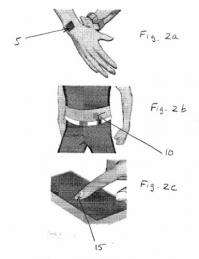March 20, 2012 report
Nokia feels out haptic feedback tattoo system for phones

(PhysOrg.com) -- Nokia, the Finnish smartphone maker, has filed a patent for a haptic communication system where tattoos will send you vibrations so you know who is calling. Your ferromagnetic ink tattoo would vibrate based on signals sent from a phone and you could customize the tattoo-phone-linked system. A special ferromagnetic ink on your skin, painted on like a tattoo, could send the various signals. The patent, filed March 15 by Nokia, proposes a material "capable of detecting a magnetic field and transferring a perceivable stimulus to the skin, wherein the perceivable stimulus relates to the magnetic field." The US patent application 20120062371 is described as a topical haptic notification system.
Nokia proposes that the material worn on the body or painted on the skin can detect a magnetic field and emit a vibration with options for different kind of haptic feedbacks, among which the user may choose to personalize the device. The magnetic field, when detected by the apparatus, would cause a different effect based on characteristics. For example, the magnetic field may cause vibration of one short pulse, multiple short pulses, a few long pulses, combined short and long pulses, strong pulses and weak pulses. Timing between pulses and/or length of pulses and/or strength of pulses would differ in response to detecting the magnetic field. In a sample embodiment, according to the patent, the phone menu may comprise a set of magnetic field options, which may comprise magnetic fields of different kinds.
The unwiredview.com site translates the patent text into plainer language. Vlad Bobleanta synthesizes the Nokia visions into more basic embodiments, of either a material that attaches to your body or wearing the phone notifier directly on the skin.
He says that in the first rendering, Nokia proposes a material that could attach to the forearm, for example, and it is that material that would detect a magnetic field and emit a vibration. In the second embodiment, the tattoo would be applied using ferromagnetic inks. The ink material would be exposed to high temperatures to demagnetize it. Then the tattoo would be applied. After the tattoo was applied, the user would need to magnetize it. The tattoo would gain enhanced sensitivity towards external alternating magnet fields.
Observers reacting to the patent news said they could see some practical use, in environments where either it would be too noisy to hear the Top 40 ringtone or other sounds and the user would thus miss an incoming call, or in an environment where it must be quiet, and standard ring tones were discouraged.
Observers also think Nokia is showing awareness of what comes next as a mobile device buzzword: touch, including vibrations. Haptic technology is a tactile feedback technology that takes advantage of a user's sense of touch by applying forces, vibrations, or motions to the user. Manufacturers, for competitive advantage, will feature devices that can attract users with novel "touch" and vibration experiences.
© 2011 PhysOrg.com

















